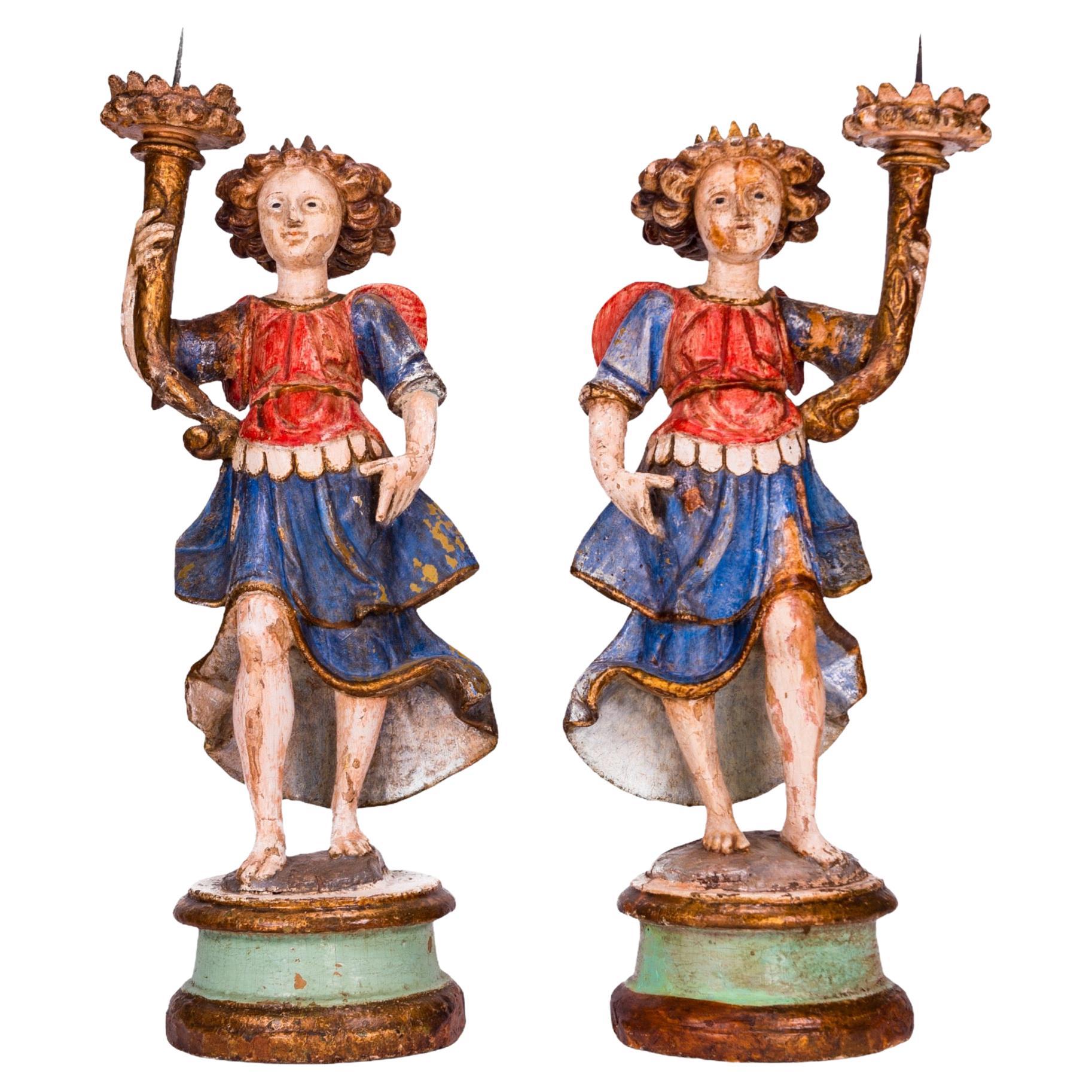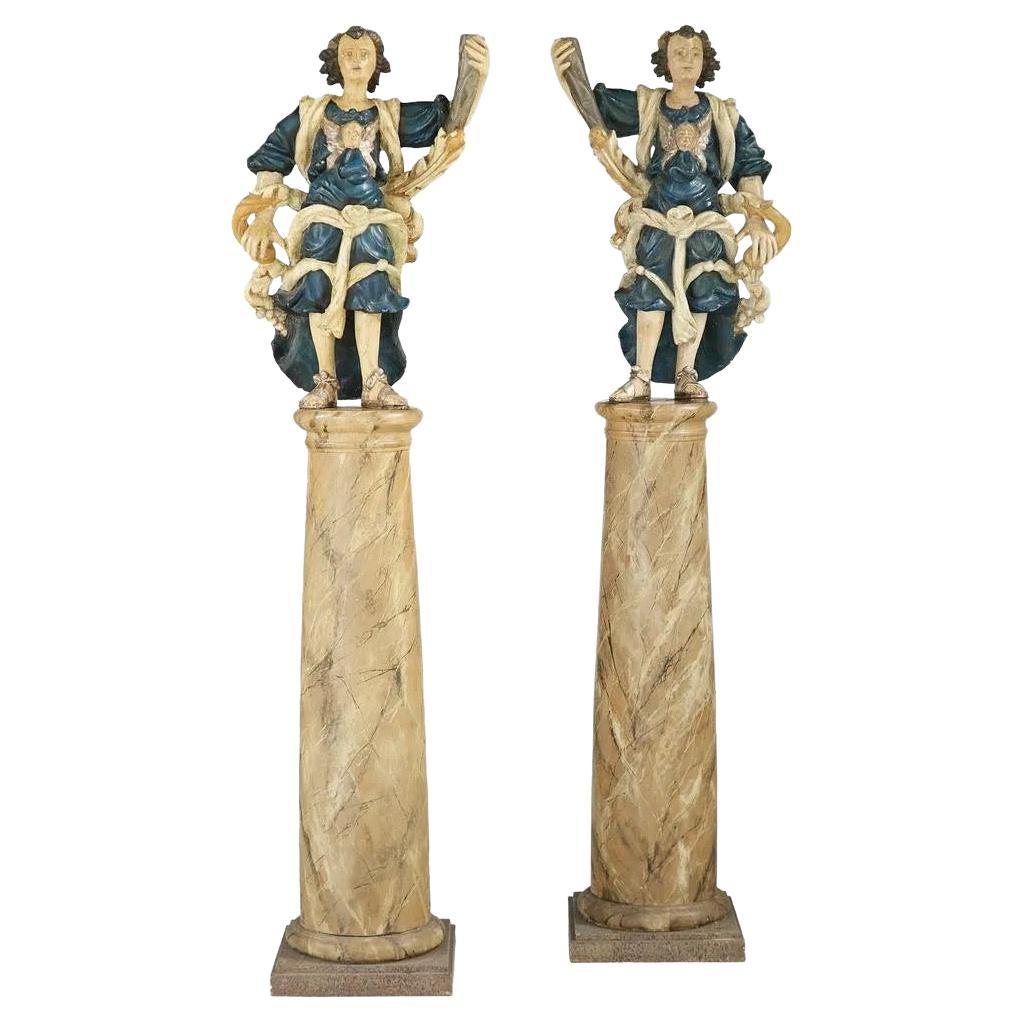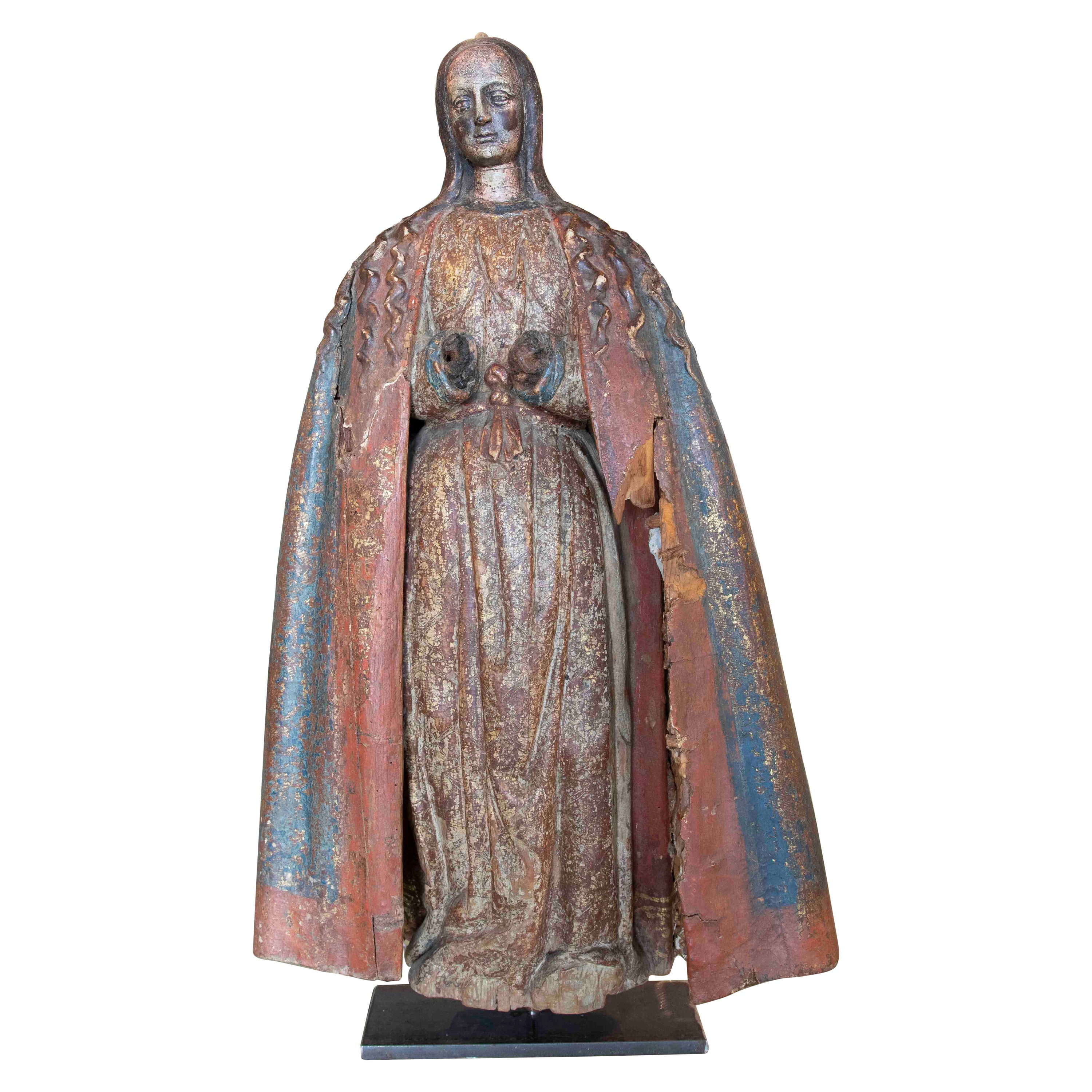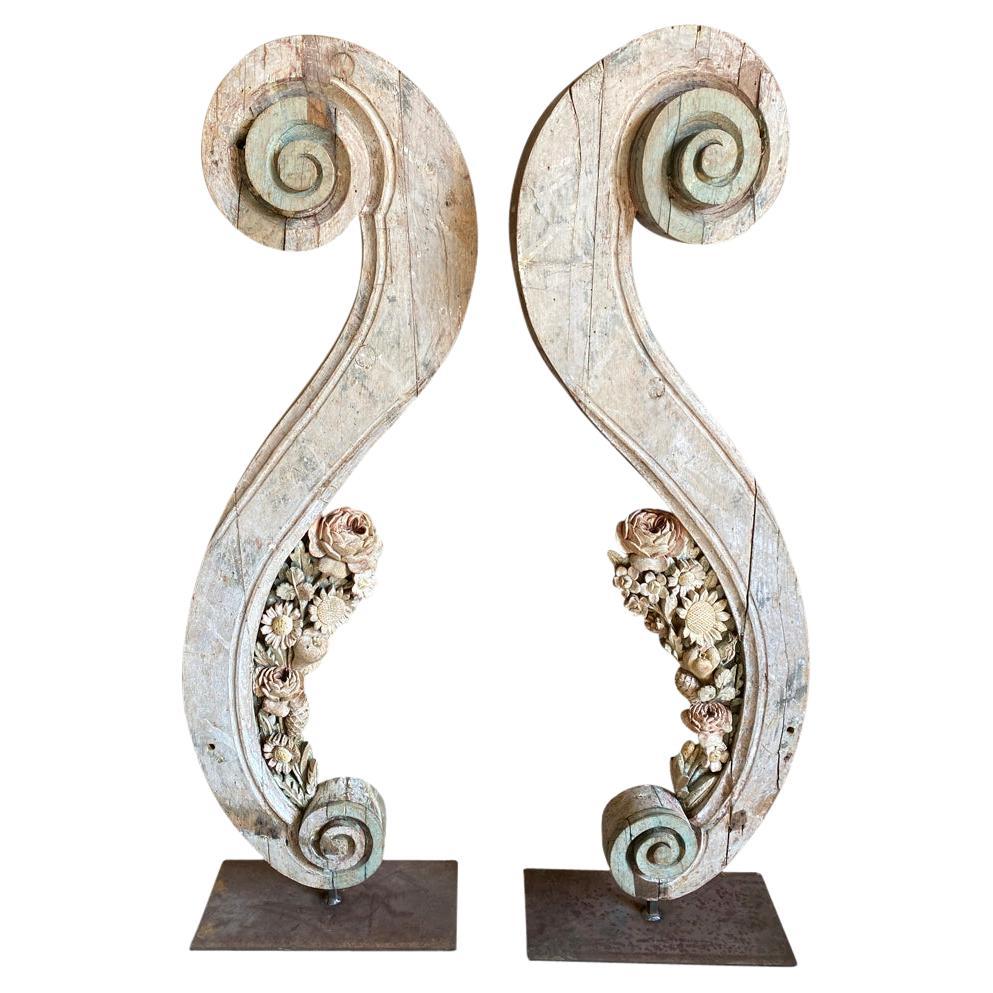Items Similar to 17th Century St. Nicholas Sculpture Polychrome Carved Wood
Want more images or videos?
Request additional images or videos from the seller
1 of 8
17th Century St. Nicholas Sculpture Polychrome Carved Wood
About the Item
17th century St. Nicholas
Polychrome carved wood, h. 133 cm
In the past, wooden statues were frequently commissioned to artists for the results of intense naturalism that emotionally involved the faithful. Furthermore, wood, lending itself more to being painted than marble or stone, accentuated its illusionism and created works of great charm and suggestion destined both for private devotion and for ecclesiastical, conventual or monastic spaces.
St. Nicholas of Bari, also known as St. Nicholas of Myra (Patara di Licia, about 270 - Myra, 343), is venerated as a saint by the Catholic Church, the Orthodox Church and several other Christian denominations, he was bishop of Myra (today Demre ). He is also known outside the Christian world because his figure gave rise to the myth of Santa Claus. His relics are kept in Bari, Venice, Rimini, Saint-Nicolas-de-Port, Bucharest, Volos and also in Bulgaria, in the church of the city of Cernomoretz. He was probably born in Patara di Licia, between 261 and 280. Growing up in an environment of Christian faith, according to the most widespread sources, he lost his parents prematurely due to the plague. He thus became the heir of a rich patrimony that he distributed among the poor and therefore remembered as a great benefactor. He later left his hometown and moved to Myra where he was ordained a priest, later becoming a bishop. Imprisoned and exiled in 305 during the persecution of Diocletian, he was then freed by Constantine in 313 and resumed his apostolic activity. It is not certain that he was one of the 318 participants in the Council of Nicaea in 325: according to tradition, however, during the council he would have harshly condemned Arianism, defending orthodoxy, and in a moment of impetus he would have slapped Arius. . The writings of Andrew of Crete and John Damascene would confirm his faith rooted in the principles of Catholic orthodoxy. he was then freed by Constantine in 313 and resumed his apostolic activity. It is not certain that he was one of the 318 participants in the Council of Nicaea in 325: according to tradition, however, during the council he would have harshly condemned Arianism, defending orthodoxy, and in a moment of impetus he would have slapped Arius. . The writings of Andrew of Crete and John Damascene would confirm his faith rooted in the principles of Catholic orthodoxy. he was then freed by Constantine in 313 and resumed his apostolic activity. It is not certain that he was one of the 318 participants in the Council of Nicaea in 325: according to tradition, however, during the council he would have harshly condemned Arianism, defending orthodoxy, and in a moment of impetus he would have slapped Arius. . The writings of Andrew of Crete and John Damascene would confirm his faith rooted in the principles of Catholic orthodoxy.
The first opportunity to show his charity was offered to him by a neighbor, a man, once well-off and now reduced to such poverty that he could not give even a small dowry to his three beautiful daughters.
The three young girls were about to take a dishonorable path, but the young Nicholas warned by God through a dream secretly sent three hoards of coins, wrapped in a handkerchief, to the poor father who was able to marry his daughters with dignity. Because of this episode, St. Nicholas, as in the work in question, is often depicted with three golden balls or three bags of coins.
The sculpture is characterized by the artist's ability to define the drapery, elegant and articulated in the rendering of the folds, as well as details such as the beard or hair analytically rendered strand by strand.
- Dimensions:Height: 52.37 in (133 cm)Width: 15.75 in (40 cm)Depth: 13.78 in (35 cm)
- Materials and Techniques:
- Place of Origin:
- Period:
- Date of Manufacture:17th Century
- Condition:Refinished. Wear consistent with age and use.
- Seller Location:Milan, IT
- Reference Number:1stDibs: LU5918226763532

About the Seller
5.0
Vetted Seller
These experienced sellers undergo a comprehensive evaluation by our team of in-house experts.
Established in 2000
1stDibs seller since 2021
25 sales on 1stDibs
Typical response time: 10 hours
- ShippingRetrieving quote...Ships From: Milan, Italy
- Return PolicyA return for this item may be initiated within 14 days of delivery.
More From This SellerView All
- Saint Roch in Polychrome Wood, 17th centuryLocated in Milan, ITXVII Century San Rocco Polychrome wood, cm h. 127 The item is in good conditionCategory
Antique 17th Century Figurative Sculptures
MaterialsFruitwood
- 17th Century St. Paul Sculpture Polychrome and Gilded WoodLocated in Milan, IT17th century. St. Paul Polychrome and gilded wood, 130 x 66 cm The sculpture analyzed here shows a strong plastic and volumetric vigor that gives a sense of immediate natur...Category
Antique 17th Century Italian Wall-mounted Sculptures
MaterialsWood
- Adoration of the Magi in polychrome terracotta, 17th centuryLocated in Milan, ITXVII Century Adoration of the Magi Polychrome terracotta, 24 x 18 cm The present relief, made of terracotta that retains the original polychromy, depicts the famous episode in the...Category
Antique 17th Century Figurative Sculptures
MaterialsPottery
- Lion Marble sculpture from the 17th centuryLocated in Milan, ITXVII Century Lion Marble, 30 x 43 x 25 The object under consideration is configured as a marble sculpture referable to the 17th century, characterized by a strong, visceral langua...Category
Antique 17th Century Italian Animal Sculptures
MaterialsMarble
- 17th Century Madonna with Child from the Impruneta Tondo Polychrome TerracottaLocated in Milan, ITTuscan school, 17th century Madonna with Child - from the Impruneta Tondo Measures: Polychrome terracotta, 65 x 46 x 10 cm This polychrome terracotta relief, gently jutting...Category
Antique 17th Century Italian Abstract Sculptures
MaterialsTerracotta
- 17th Century Cricifix BoxwoodLocated in Milan, IT17th century Crucifix Measures: Boxwood, 42 cm high x 8 x 14 The sculpture depicting the crucified Christ examined here represents a refined example of seventeenth-century cabinetry in boxwood. The figure of Christ, now dead on the cross, is part of a precious artistic choreography with the structure of the cross and its pedestal, both decorated with tortoiseshell mirrors, ivory threads to emphasize the structure of the cross and elements in ebonized and carved wood to highlight the architectural structure of the pedestal. The departure of Christ is evident from the lowered head, from the open hands...Category
Antique 17th Century Italian Figurative Sculptures
MaterialsBoxwood
You May Also Like
- Candle Holders, 17th Century Italian Polychromed Carved WoodLocated in North Miami, FLA pair of early 17th Century Baroque polychromed carved wood Angel sculptures with torch shaped candleholders.Category
Antique 17th Century Italian Baroque Figurative Sculptures
MaterialsGold Leaf
- 17th Century 'Baroque' Pair of Italian Carved and Polychromed SculpturesLocated in North Miami, FL17th Century (Baroque) pair of Italian carved and polychromed figures. Each statue is holding a torchere and are mounted on their original turned wooden faux marble column.Category
Antique 17th Century Italian Baroque Figurative Sculptures
MaterialsWood, Paint
- 17th Century Spanish Polychromed Wooden Carved Sculpture of a Virgin MaryLocated in Marbella, ES17th century Spanish Polychromed Wooden Carved Sculpture of a Virgin Mary.Category
Antique Mid-17th Century Spanish Figurative Sculptures
MaterialsWood
- Saint Francis Xavier Sculpture, 17th Century, Carved WoodLocated in North Miami, FL17th Century Spanish carved oak wood sculpture of Saint Francis Xavier, the co-founder of the society of Jesus.Category
Antique 17th Century Spanish Baroque Figurative Sculptures
MaterialsOak, Wood
- Pair Of French 17th Century Carved Wood SculpturesLocated in Atlanta, GAAn exquisite pair of 17th century decorative sculptures expertly carved from painted oak from the South of France. Beautiful "S" shaped each adorned with wonderful flowers - roses, s...Category
Antique 17th Century French Architectural Elements
MaterialsOak
- 17th Century Carved Wood Silver Gilt Polychrome Figure of Saint JohnLocated in Vero Beach, FLLarge Saint John the Evangelist figure created in the workshop of Franz Matthias Hiernle in Mainz, Germany. The superbly carved and highly decorated slender figure, in an elegant and...Category
Antique 17th Century German Baroque Figurative Sculptures
MaterialsWood, Giltwood
Recently Viewed
View AllMore Ways To Browse
Antique Wood Works
Used Furniture St Johns
Carved Wood Golden
Coin Wood
Antique Furniture St Johns
Wood Bags
Brown Wood Balls
Wooden Sculpture Man
Carved Wood Saint
Polychrome Marble
Christian Carved
Hand Painted Bags
Carved Stone Charm
Italian Statue Wood
Hand Carved Wood Sculpture Man
Hand Carved Wood Saint
Hand Carved Wooden Statue
Saint Sculpture Carved Wood





